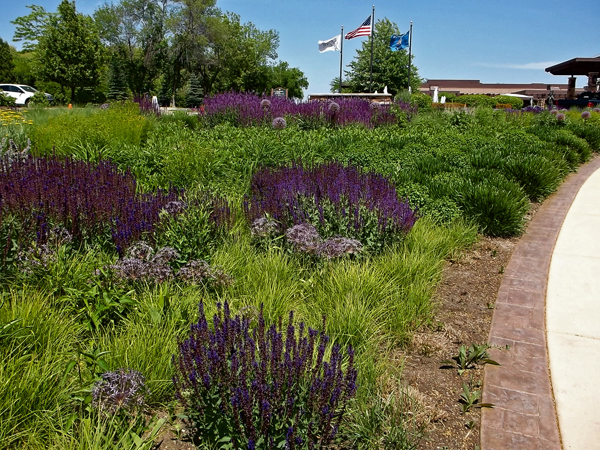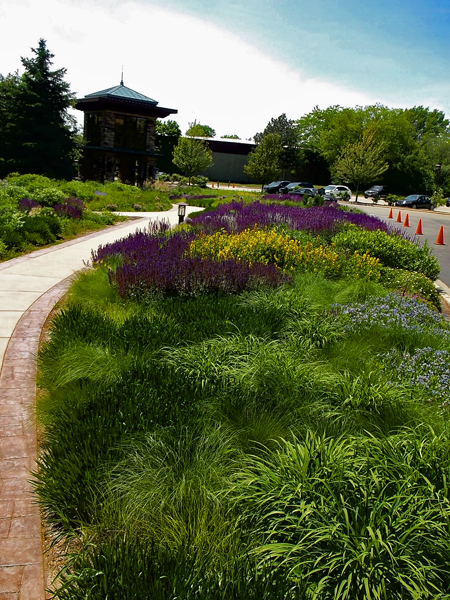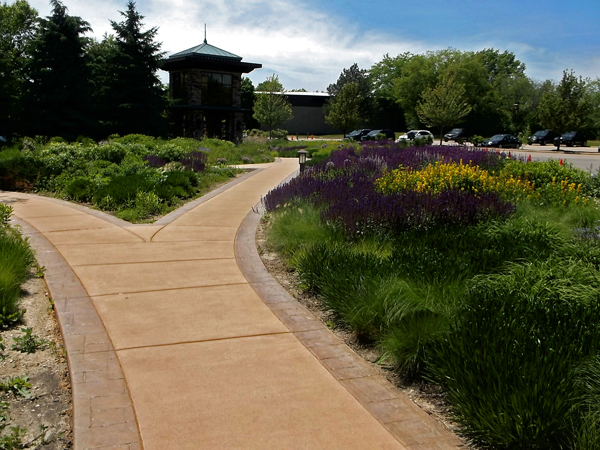
Last July, I visited Grand Geneva Resort and Spa, not to play a round of golf, but to check in on the Roy Diblik designed garden that they have out in front of the main building – you can read more about that <here>. This past week, I took another look at the garden, this time in Mid-June. While there where many colors showing in July, shades of purple dominated the palette in Mid-June. In the photo above, the globular flowers of Giant Purple Allium (a Dutch Bulb) complement the various shades of Blue Salvia.
In the foreground the monochromatic color scheme is set of by bright green masses of Sesleria autumnalis, Autumn Moor Grass.
In the photo below the dark green strappy leaves of Allium ‘Summer Beauty’ weave in and out of the small gray-green leaves of Catmint (Calamentha nepeta var. nepeta.) In a few weeks both of these will be in bloom with balls of pink flowers and a mist of white flowers respectively.

‘Summer Beauty’ Allium and Catmint, in the foreground, with Purple Stachys ‘Hummelo’ behind, in bloom last July
The Purple Coneflower in the center foreground waits its turn to put on its show of flowers, while the Yellow Baptisia (Baptisia sphaerocarpa) is just finishing up and starting to set its ornamental bean-like seed pods.
Bowman’s Root (Gillenia trofoliata, now known as Porteranthus trifoliatus) is native to the Eastern half of the United States (including Illinois) and parts of Ontario, Canada. Tolerant of Shade (naturally found growing in moist woods) is can take full sun as well. American Indians used the plant extensively in their herbal medicines, which you can read more about at the University of Michigan’s website <here.> The plant can reach heights of 2 to 3 feet or more, with an equal spread. The Plant is covered with 1″ five petaled, star shaped flowers, the fall color is an excellent orange/red color.
Green is also a color, not just a backgound to other colors, as displayed in the two images below:
Willow Leaved Amsonia ‘Blue Ice’ along with ‘Max Frie’ Geranium:
Monarda bradburiana, a short, early blooming, native horsemint is surrounded by soon to be blooming yellow Threadleaf Coreopsis:
A mass of Giant Purple Allium among the native Prairie Dropseed (Sporobolis heterolepis) grass:
A similar view of the garden last July:
Prairie Dropseed grass (foreground, left) knits throughout the garden:
Geranium, Salvia, and Giant Allium, all in shades of purple:
Yellow Baptisia fading behind the bright yellow of ‘Moonshine’ Yarrow:
In another part of the property, prairie native, White Wild Indigo (Baptisia Leucantha) blooms in profusion, its grey leaves add an addition layer of interest to this easy to grow and well behaved Midwestern native:
Not too much going on in this little bed in Mid- June:
But the same bed a few weeks later, in Early July of last year, is a real riot of color – the garden is designed to change throughout the growing season with layers of color emerging as others fade.
And that is why I enjoy visiting gardens designed by Roy at different times of the year – it’s a great lesson in how to arrange plants so even when they are not in flower, the planting is still an interesting mix of textures and plant forms … at some point in the season though, each part of the garden, or plant combination, has its moment in the sun -just like fireworks on the fourth of July – each successive display is unique and awesome in its own way. And just when you think you’ve seen the best, a new display explodes before you with another amazing mix of colors and forms.





















